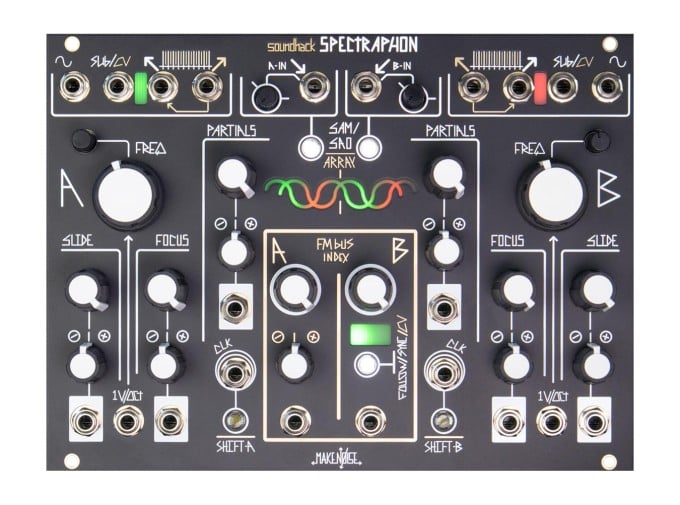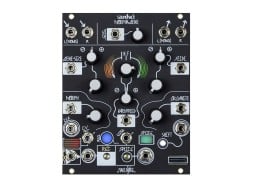Make Noisesoundhack Spectraphon Dual Spectral Oscillator
-
 Free
Free
Shipping -
 No Hassle
No Hassle
Returns -
 Extended
Extended
Warranty -
 Low Prices
Low Prices
Guaranteed
Make Noise soundhack Spectraphon
The Make Noise Soundhack Spectraphon is an advanced dual digital oscillator module for Eurorack synthesizer systems, with a design based on Buchla-style complex oscillators, additive synthesis, and resynthesis. While the typical complex oscillator derives much of its sonic interest from analog waveshaping, Spectraphon takes a different approach entirely: you can think of it as an oscillator whose instantaneous timbre is driven by external audio sources. In fact, it generates its output spectra by analyzing and re-creating the overtone characteristics of other sounds—by way of a clever, intuitive implementation of resynthesis.
Spectraphon is a dual oscillator module with a physical layout somewhat similar to the typical Buchla-style complex oscillator—however, rather than having different "Principal" and "Modulation" oscillators, each of Spectraphon's oscillators is nearly identical. Each offers a variety of outputs, including a sine wave output, Sub/CV output, and Odd and Even harmonic outputs. The Odd and Even harmonic outputs can be shaped and manipulated by a variety of onboard controls: Slide, Focus, and Partials all affect the sound at these outputs. Like a typical complex oscillator, Spectraphon features a central modulation bus, which enables inter-oscillator frequency modulation. Interestingly, FM in Spectraphon affects only the Odd and Even harmonic outputs, and does not impact the oscillator "core" directly; so, you can perform bi-directional FM without inducing chaotic cross modulation. Happily the FM gets insanely deep, perfect for wild, otherworldly sounds.
Spectraphon's oscillators have two modes of operation: Spectral Amplitude Modulation (SAM) and Spectral Array Oscillation (SAO). Each oscillator can be switched to either mode independently of one another. In SAM mode, Spectraphon analyzes audio at the A-In or B-In jacks, and uses it as a means of mapping an overtone structure onto the output of the oscillator in question—instantaneously "resynthesizing" the sound at the Odd and Even harmonic outputs. The nature of the mapping can be altered with the Slide control, shifting the spectral focus up and down the oscillator's own spectrum. The Focus control acts like a sort of spectral "blurring" effect, causing Spectraphon to ring and linger on particularly prominent overtones. The Partials control affects the presence of overtones at the Odd and Even harmonic outputs—completely silent when fully counterclockwise, and increasingly loud/brigt as the knob is turned or external CV is applied. You can think of Partials as being similar to a low pass filter or low pass gate, and it's an excellent place to apply envelopes or other fluctuating CV signals.
At any given moment in SAM mode, you can choose to create an Array of Spectra—during which process Spectraphon captures over 1000 snapshots of the incoming sound over the course of roughly one second. Each of the Spectra are, in essence, an analysis of the sound's overtone characteristics at the moment they were captured. Spectraphon can save sixteen such Arrays for each of the two oscillators. When you switch to SAO mode, you can use these Arrays as the basis of the oscillator's sound. In this mode, the Slide and Focus controls allow you to "scrub" through the array, acting as coarse and fine scrubbing controls, respectively. This enables everything from time-stretched resynthesis of external audio, to reversed sounds, jumbled-up modulated tones, and much more
Spectraphon is full of other tricks. For instance, the Sub/CV outputs can produce clock-able stepped random, smooth random, and triangle LFO outputs; in SAM mode, they can also produce an envelope follower signal, and in SAO mode, they can produce a suboscillator tone. In SAO mode, the A and/or B inputs/knobs can continuously offset the Even harmonic outputs' frequencies. The B oscillator can follow the A oscillator's pitch, or can be hard synced to it. FM and sync work in both SAM or SAO modes, making it possible to frequency modulate external sounds, hard sync resynthesized tones, and much more.
Spectraphon is capable of much more than we can disclose in the context of a simple product listing, but perhaps the key point is this: Spectraphon is Make Noise's most ambitious design to date. It's a complex digital audio processor and sound generator, capable of everything from vocoder-like or resonator-like behavior to the creation of full, multi-voice synthesizer textures. If you want an entirely new approach to additive synthesis and resynthesis, or are just looking for a fresh, unfamiliar sonic flavor for your Eurorack system—Spectraphon is it.
soundhack Spectraphon Features
- Digital complex dual oscillator inspired by classic designs by Don Buchla
- Leverages a unique approach to additive synthesis and resynthesis as the basis for its sound creation
- Developed in collaboration with Tom Erbe of Soundhack, using a DSP platform created by Jeff Snyder of Snyderphonics
- Can be used as an audio processor or sound generator
- Two fully-equipped additive/resynthesis-based oscillators with a near-identical control set
- Deep, dynamic internal inter-oscillator FM available via the bi-directional FM bus
- Each oscillator can individual be switched between Spectral Amplitude Modulation (SAM) and Spectral Array Oscillation (SAO) modes
- In SAM mode, the oscillator tracks the timbre of external audio sources and resynthesizes their spectrum at the output
- In SAO mode, the oscillator uses stored arrays of spectra captured from external sources in order to re-construct and re-arrange characteristics of the original sound
- Each side can store 16 Arrays of Spectra
- Oscillator B can pitch track or hard sync to Oscillator A
- Individual outputs per side for Odd and Even harmonics
- Continuous timbre control in SAM and SAO modes via Partials, Slide, and Focus controls—each with dedicated CV inputs and attenuverters
- Sub/CV outputs can produce suboscillator tones, envelope follower signals, or stepped random, smooth random, or triangle LFO clockable modulation signals
- Low noise, high audio performance, and downright fun and interesting
- Eurorack module
- Width: 34hp
- Depth: 36mm
- Current draw: 230mA @ +12V, 55mA @ -12V
 The Long Hum: a Deep Dive into the Ephemeral World of DroneFrom Mystical Origins to Modern Drone MachinesMake Noise Strikes Again: the New DXG Dual Stereo GateThe Newest in Make Noise's History of Iconic LPG DesignsInfinite Textures: Make Noise Soundhack SpectraphonComplex Oscillators, Additive Synthesis, Resynthesis, and YouStaff Picks: Best Gear of the Year 2023Our Favorite Eurorack Modules, Pedals, and Synthesizers of 2023Superbooth 2023 Coverage: In DepthSynthesizers + SpectralismTechnos Acxel ResynthesizerTelegraphic Harmonies: A Brief History of the TelharmoniumThe Life and Demise of One of the First Electronic Musical InstrumentsSynthesis Methods Explained: What is Additive Synthesis?Concepts in Acoustics + Harnessing Complexity for Sound Design
The Long Hum: a Deep Dive into the Ephemeral World of DroneFrom Mystical Origins to Modern Drone MachinesMake Noise Strikes Again: the New DXG Dual Stereo GateThe Newest in Make Noise's History of Iconic LPG DesignsInfinite Textures: Make Noise Soundhack SpectraphonComplex Oscillators, Additive Synthesis, Resynthesis, and YouStaff Picks: Best Gear of the Year 2023Our Favorite Eurorack Modules, Pedals, and Synthesizers of 2023Superbooth 2023 Coverage: In DepthSynthesizers + SpectralismTechnos Acxel ResynthesizerTelegraphic Harmonies: A Brief History of the TelharmoniumThe Life and Demise of One of the First Electronic Musical InstrumentsSynthesis Methods Explained: What is Additive Synthesis?Concepts in Acoustics + Harnessing Complexity for Sound DesignRather than relying on wavefolding, Spectraphon is all about additive synthesis and resynthesis: you can think of it as an oscillator whose timbre is driven by external sound sources. Inspired by the Buchla 296 Programmable Spectral Processor and Touché hybrid keyboard synthesizer, it presents a new and novel take on sound generation and processing.
As a live processor, Spectraphon can be like a vocoder, a resonator, a pseudo-spectral freeze; as an oscillator, it creates a wide range of evolving tones based on stored analyses of external sounds. It's a dense module—so in this video, we dive into how it works and how it sounds.
We are THRILLED to finally share our latest collaboration with Tom Erbe (soundhack), The Spectraphon!





